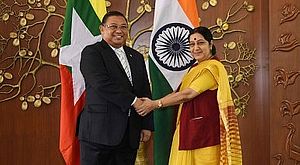This week, Myanmar’s military chief Senior General Min Aung Hlaing began his much-anticipated four-day visit to India.
On his trip, he and the rest of his high-level military delegation were expected to meet top political and military leaders including Prime Minister Narendra Modi, Defense Minister Manohar Parrikar and Army Chief Dalbir Singh. India-Myanmar border cooperation is expected to dominate discussions during the week, since the visit comes over a month after New Delhi conducted a controversial cross-border raid on insurgent camps (See: “The Truth About India’s Militant Strike in Myanmar”).
But ahead of those talks, the delegation visited Goa Shipyard Limited (GSL). According to sources, they visited the Indian Navy’s local bases and the two sides held wide-ranging discussions on maritime strategy, ship-building and maritime deployment.
Beyond these conversations, media reports indicate that there may be some movement towards future defense cooperation. According to Times of India, Shekhar Mital, chairman and managing director of GSL, said the visiting military delegation was “very keen” on India’s offshore patrol vessels (OPV) in particular. While project approval was stuck for now due to sanctions, Mital said “it is only a matter of time before the approval is given.” Mital personally briefed Min Aung Hlaing on the ongoing construction of OPVs in India for its own capabilities as well as for export. The delegation was also shown efforts being undertaken in the mine countermeasures vessels (MCMV) project.
The progress on bilateral defense ties is not altogether surprising. Following the first meeting of the India-Myanmar Joint Consultative Commission on July 16, the defense and security portion of the joint statement – again dominated by border issues – also included a paragraph noting India’s commitment to supporting “the modernization of Myanmar Armed Forces”. Though specifics were still notably lacking, there were references to military to military cooperation in terms of training as well as cooperation “in building a professional and capable Myanmar Navy to safeguard and ensure its maritime security.”
India under the Modi government has also demonstrated the capability and willingness to boost the naval capabilities of its neighbors in a similar fashion. Last December, India delivered an offshore patrol vessel to Mauritius, making it India’s first indigenously built ship for export. Indian shipyards are also currently contracted to construct two OPVs for Sri Lanka.
Yet it is still early days, and it remains to be seen whether there will be sufficient follow through. Those who follow the bilateral relationship closely know that New Delhi and Naypyidaw have discussed such defense arrangements even before Modi came to power. Indeed, as early as mid-2013, the two countries were said to have reached a decision to build OPVs for Myanmar in Indian shipyards and provide training to Myanmar Navy officers and sailors at Indian establishments. But as Nilanthi Sarmaranayake of the Center for Naval Analyses recently noted, while Myanmar has received platforms, equipment and training from India, “progress is not yet evident” especially on the OPV front.

































